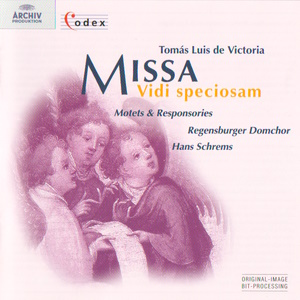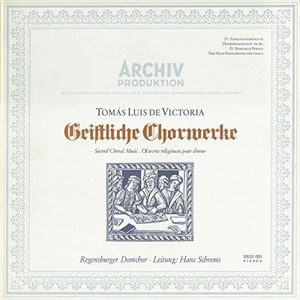 |
|
1 CD -
453 164-2 - (p) 1996
|
|
50
Jahre (1947-1997) - Codex I Serie - 3/10
|
|
|
|
|
|
|
|
Tomás
Luis de VICTORIA (c.1548-1611)
|
Missa
"Vidi speciosam" - à 6
|
|
17' 09" |
|
|
-
Kyrie
|
1' 46" |
|
1 |
|
-
Gloria
|
3' 44" |
|
2 |
|
-
Credo |
5' 43" |
|
3 |
|
-
Sanctus
|
1' 34" |
|
4 |
|
-
Benedictus |
1' 42" |
|
5 |
|
-
Agnus Dei |
2' 40" |
|
6 |
|
Motets
& Responsories
|
|
|
|
|
-
Vidi speciosam - motet à 6 |
|
6' 14" |
7 |
|
-
Tamquam ad latronem - responsory
à 4
|
|
3' 23" |
8 |
|
-
O Domine Jesu Christe - motet à
6
|
|
2' 52" |
9 |
|
-
Amicus meus - responsory à 4
|
|
2' 44" |
10 |
|
-
Unus ex discipulis meis - responsory
à 4
|
|
2' 13" |
11 |
|
-
Aleph. Ego vir videns paupertam meam
- à 5; from Lamentationes
of Jeremiah
|
|
6' 56" |
12 |
|
-
Caligaverunt oculi mei - responsory
à 4
|
|
3' 29" |
13 |
|
-
Dum complerentus - motet à 5
|
|
5' 41" |
14 |
|
-
Surrexit Pastor Bonus - motet à
6 *
|
|
2' 50" |
15 |
|
|
|
|
REGENSBURGER
DOMCHOR
Hans SCHREMS, Director
|
|
|
|
|
|
Luogo
e data di registrazione |
|
St.
Emmeran, Regensburg (Germania)-
6-10 luglio 1969 (1-14)
|
|
|
Original
Editions |
|
Archiv
Produktion | 2533 051 | 1 LP | (p)
1970 | ANA | 1-14)
|
|
|
Edizione
"Codex"
|
|
Archiv
Produktion "Codex" | 453 164-2 |
durata 54' 23" | LC 0113 | 1 CD |
(p) 1996 | ADD | stereo
|
|
|
Produced by |
|
Dr.
Manfred Richter
|
|
|
Tonmeister
(Balance Engineer)
|
|
Klaus
Scheibe
|
|
|
Editing |
|
Joachim
Niss
|
|
|
Cover |
|
Meister
der hl. Veronica "Die heilige
Veronika mit dem Schweißtuch
Christi" (detail); Munich, Alte
Pinakothek
|
|
|
Art Direction
|
|
Fred
Münzmaier
|
|
|
Note |
|
No
traceable indication concerning
track number 15*.
Original-Image-Bit-Processing -
Added presence and brilliance,
greater spatial definition |
|
|
|
|
|
ORIGINAL
EDITIONS

1 LP - 2533 051 - (p) 1970
|
Treasures
from Archiv Produktion’s
Catalogue
A rare and valuable collection of
documents is the pride of any
library or archive. CODEX, Archiv
Produktion’s new series, presents
rare documents in sound from 50
years of pioneering recording.
These recordings have been
digitally remastered using
original-image bit-processing
technology and can now be
appreciated in all the richness of
their original sound-image. They
range from the serene counterpoint
of a Machaut, the intensely
spiritual polyphony of a Victoria,
to the imposing state-music of a
Handel.
For the artists on Archiv
Produktion recordings, a constant
aim has been to rediscover the
musical pulse of past times and to
recreate the spirit of past ages.
In this sense each performance
here - whether by Pro Musica
Antiqua of Brussels in the 1950s,
the Regensburg Domchor in the
1960s, or Kenneth Gilbert and
Trevor Pinnock in the 1970s - made
a vital contribution to the
revival of Early Music in our
time.
CODEX highlights recordings that
were unique in their day, many of
them first recordings ever of this
rare and remarkable repertoire,
now appearing for the first time on
CD. A special aspect of the
history of performance in our
century can now be revisited, as
great moments from Archiv
Produktion’s recording history are
restored and experienced afresh.
Dr.
Peter Czornyi
Director,
Archiv Produktion
VICTORIA: MISSA “VIDI
SPECIOSAM” - MOTETS &
RESPONSORIES
Tomás Luis de Victoria was one of
the principal Spanish composers of
his time who became known and, in
the case of Victoria, even famous
outside their own country. He
spent a great part of his life in
Rome, where he was active as
organist and choirmaster at
various churches. Then from 1587
onward he was the foremost
musician of the Spanish capital
Madrid, where he was entrusted
with highly responsible tasks.
“The Spaniard, enduring the
sufferings of the Crucified with a
glowing fervor that becomes almost
sensual in its dramatic passion”
(P. H. Lang), devoted his life as
a composer exclusively to
liturgical music from which some
selected pieces are recorded here.
Victoria modeled his Mass Vidi
speciosam a 6 on his
Assumption motet of the same name
(a 6), first published in
his 1572 motet collection. Like
the two five-part motets from the
same book already used as parody
sources, Ascendens Christus
and Dum complerentur, the
Vidi speciosam (2 partes)
is in responsory-form (aBcB) - the
length of “B” approximating that
of “a” or “c”. The motet Vidi
speciosam abounds in archaic
dissonance-treatment, and in
tantalizing chromaticisms. There
is a leap up a fourth from a
dissonant (i. e. non-harmonic)
note and a series of ornamental
resolutions involving dissonant
undernotes approached by leap.
In the Mass, on the other hand,
Victoria uses no non-harmonic
notes. Neither does he ever skip
to any dissonant undernote when
ornamenting resolutions. The
Crucifixus (a 4) repeats at
bars 80-83 (“Et iterum”) the same
chromatic ascent found at “et
lilia” in the motet. Between the
antepenultimate and penultimate
bars of the Benedictus, the bass
outlines the first three notes of
the nota cambiata figure:
after which the bassus leaps up a
fourth. The so-called consonant
fourth occurs twice during the
Credo in this form.
The Vidi speciosam brings
the total of Victoria’s masses
parodied after Canticum
canticorum motets to four;
the other Masses are: Quam
pulchri sunt (Song of
Songs, 7:1), Surge
propera (2:10), and Trahe
me (1:3). Cristóbal de
Morales wrote only one such Mass -
Vulnerasti cor meum (Song
of Songs, 4:9); Francisco
Guerrero also composed only one -
Surge propera amica mea
(2:10). Because of Victoria’s
disproportionate attention to
texts from this love poetry, he
occupies a unique position among
Spanish composers. His concern
with Song of Songs texts
allies him with the most
celebrated of contemporary Spanish
poets, Fray Luis de León
(1527-1591): a major cause of
whose imprisonment, from March
1572 until December 1576, was his
translation into the vernacular of
the book that contains more
perfumed language than any other
in the Old Testament. The ardor,
the longing, and the ectasy of
this unique book invaded
Victoria’s motets; and in turn
such a Mass as this, parodied
after a Canticle motet.
Vidi speciosam, last of the
Canticle Masses and last
ofVictoria’s six-voice Masses
(excluding the 1605 Requiem), is
also his last without an organ
accompaniment. As in the opening
of the motet, so also in the Mass,
he effectively contrasts the lower
three voices with the upper three;
such antiphony, quoting bars 1-9
of the source motet, distinguishes
the outset of both Kyrie I and the
Sanctus. Although he makes more
use of material drawn from pars
1 than pars 2 in
this parody - as in the Dum
complerentur Mass - he does
draw now and then on pars 2
as well.
The motet Dum complerentur a 5
from the same 1572 maiden
collection shares with
Palestrina’s Pentecost motet of
identical name (Rome, 1569)
several significant features. (1)
Their motets are both in two partes,
each of which sets an exactly
equal amount of text. (2) Both are
responsory-form motets - the “B”
in Palestrina’s aBcB reaching 32
breves; in Victoria’s 31. (In
both, “B” is ushered in with the
words “tamquam spiritus
vehementis”.) (3) Not only do the
two composers choose the same
amount of text for both partes;
and the two adopt the same aBcB
form, but also they each use
approximately the same amount of
canvas over which to paint their
two panels: 84+66 breves in
Palestrina’s motet; 86 + 76 in
Victoria’s.
To look now at their diptychs in
another light and to study the
differences: (1) In Palestrina’s
setting a 6 ending on F
major (Bb key signature), interior
parts often cross each other; but
cantus and bassus are never
crossed by any inner voice. In
Victoria’s setting a 5
closing on G (Bb key signature),
cantus and quintus cross
constantly. Moreover, they switch
roles in the second “B” of aBcB.
By virtue of their constant
crossing they create a synthetic
top vocal line that throughout
both partes constantly
hovers around one note, d1. This
hovering creates a mood of
expectancy that corresponds with
the excited, “on-edge” mood of the
text (Acts 2:1-2). (2) Palestrina
takes a “black-and-white” picture
specifying only 3 accidentals in
150 brcvcs. Victoria shoots his in
technicolor - specifying 135
accidentals in 162 breves. This
number would no doubt have been
even greater had he, like
Palestrina, called for six instead
of five voices.
The other works recorded here
belong to Victoria’s one
publication dedicated to no
earthly patron but to the Deity -
the Officium Hebdomadae
Sanctae (1585). O Domine
Jesu Christe for Palm Sunday
had already appeared in the 1572
motet collection, but the
responsories Amicus meus
and Unus ex discipulis for
Maundy Thursday, Tamquam ad
latronem and Caligaverunt
for Good Friday, and the
Lamentation Aleph. Ego
vir were making their first
appearance in print. No other
works of Victoria have so
enduringly engraved his fame as
his O vos omnes, Vere
languores, and the other
heartfelt outpourings contained in
this superb Holy Week Collection.
These are his works that rain
tears, as do perhaps no other
manifestations of Spanish art.
Robert
Stevenson
For this reissue, an additional
motet, Surrexit Pastor Bonus,
from Victoria’s collection of
1572, has been released for the
first time. In this joyful
celebration of Christ the Good
Shepherd’s resurrection, Victoria
makes skilful interplay between
the upper and lower three voices,
ending with a resounding sequence
of Alleluias.
|
|
|
|